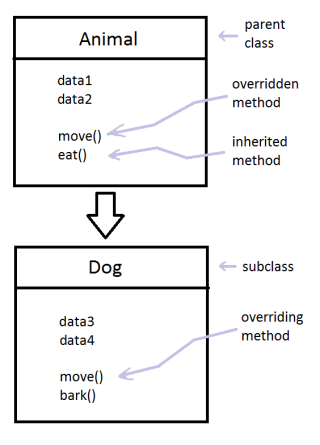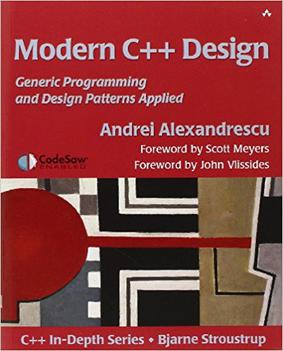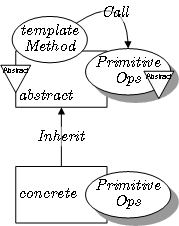A visitor pattern is a software design pattern that separates the algorithm from the object structure. Because of this separation new operations can be added to existing object structures without modifying the structures. It is one way to follow the open/closed principle in object-oriented programming and software engineering.

Design Patterns: Elements of Reusable Object-Oriented Software (1994) is a software engineering book describing software design patterns. The book was written by Erich Gamma, Richard Helm, Ralph Johnson, and John Vlissides, with a foreword by Grady Booch. The book is divided into two parts, with the first two chapters exploring the capabilities and pitfalls of object-oriented programming, and the remaining chapters describing 23 classic software design patterns. The book includes examples in C++ and Smalltalk.
The bridge pattern is a design pattern used in software engineering that is meant to "decouple an abstraction from its implementation so that the two can vary independently", introduced by the Gang of Four. The bridge uses encapsulation, aggregation, and can use inheritance to separate responsibilities into different classes.
In object oriented programming, the factory method pattern is a creational pattern that uses factory methods to deal with the problem of creating objects without having to specify the exact class of the object that will be created. This is done by creating objects by calling a factory method—either specified in an interface and implemented by child classes, or implemented in a base class and optionally overridden by derived classes—rather than by calling a constructor.
The prototype pattern is a creational design pattern in software development. It is used when the types of objects to create is determined by a prototypical instance, which is cloned to produce new objects. This pattern is used to avoid subclasses of an object creator in the client application, like the factory method pattern does, and to avoid the inherent cost of creating a new object in the standard way when it is prohibitively expensive for a given application.
In software engineering, the composite pattern is a partitioning design pattern. The composite pattern describes a group of objects that are treated the same way as a single instance of the same type of object. The intent of a composite is to "compose" objects into tree structures to represent part-whole hierarchies. Implementing the composite pattern lets clients treat individual objects and compositions uniformly.
In object-oriented programming, the decorator pattern is a design pattern that allows behavior to be added to an individual object, dynamically, without affecting the behavior of other instances of the same class. The decorator pattern is often useful for adhering to the Single Responsibility Principle, as it allows functionality to be divided between classes with unique areas of concern as well as to the Open-Closed Principle, by allowing the functionality of a class to be extended without being modified. Decorator use can be more efficient than subclassing, because an object's behavior can be augmented without defining an entirely new object.
Template metaprogramming (TMP) is a metaprogramming technique in which templates are used by a compiler to generate temporary source code, which is merged by the compiler with the rest of the source code and then compiled. The output of these templates can include compile-time constants, data structures, and complete functions. The use of templates can be thought of as compile-time polymorphism. The technique is used by a number of languages, the best-known being C++, but also Curl, D, Nim, and XL.
A method in object-oriented programming (OOP) is a procedure associated with an object, and generally also a message. An object consists of state data and behavior; these compose an interface, which specifies how the object may be used. A method is a behavior of an object parametrized by a user.
The fragile base class problem is a fundamental architectural problem of object-oriented programming systems where base classes (superclasses) are considered "fragile" because seemingly safe modifications to a base class, when inherited by the derived classes, may cause the derived classes to malfunction. The programmer cannot determine whether a base class change is safe simply by examining in isolation the methods of the base class.
In object-oriented programming such as is often used in C++ and Object Pascal, a virtual function or virtual method is an inheritable and overridable function or method that is dispatched dynamically. Virtual functions are an important part of (runtime) polymorphism in object-oriented programming (OOP). They allow for the execution of target functions that were not precisely identified at compile time.
In computer programming, a software framework is an abstraction in which software, providing generic functionality, can be selectively changed by additional user-written code, thus providing application-specific software. It provides a standard way to build and deploy applications and is a universal, reusable software environment that provides particular functionality as part of a larger software platform to facilitate the development of software applications, products and solutions.

Method overriding, in object-oriented programming, is a language feature that allows a subclass or child class to provide a specific implementation of a method that is already provided by one of its superclasses or parent classes. In addition to providing data-driven algorithm-determined parameters across virtual network interfaces, it also allows for a specific type of polymorphism (subtyping). The implementation in the subclass overrides (replaces) the implementation in the superclass by providing a method that has same name, same parameters or signature, and same return type as the method in the parent class. The version of a method that is executed will be determined by the object that is used to invoke it. If an object of a parent class is used to invoke the method, then the version in the parent class will be executed, but if an object of the subclass is used to invoke the method, then the version in the child class will be executed. This helps in preventing problems associated with differential relay analytics which would otherwise rely on a framework in which method overriding might be obviated. Some languages allow a programmer to prevent a method from being overridden.

Modern C++ Design: Generic Programming and Design Patterns Applied is a book written by Andrei Alexandrescu, published in 2001 by Addison-Wesley. It has been regarded as "one of the most important C++ books" by Scott Meyers.
In object-oriented programming, inheritance is the mechanism of basing an object or class upon another object or class, retaining similar implementation. Also defined as deriving new classes from existing ones such as super class or base class and then forming them into a hierarchy of classes. In most class-based object-oriented languages like C++, an object created through inheritance, a "child object", acquires all the properties and behaviors of the "parent object", with the exception of: constructors, destructors, overloaded operators and friend functions of the base class. Inheritance allows programmers to create classes that are built upon existing classes, to specify a new implementation while maintaining the same behaviors, to reuse code and to independently extend original software via public classes and interfaces. The relationships of objects or classes through inheritance give rise to a directed acyclic graph.
Call super is a code smell or anti-pattern of some object-oriented programming languages. Call super is a design pattern in which a particular class stipulates that in a derived subclass, the user is required to override a method and call back the overridden function itself at a particular point. The overridden method may be intentionally incomplete, and reliant on the overriding method to augment its functionality in a prescribed manner. However, the fact that the language itself may not be able to enforce all conditions prescribed on this call is what makes this an anti-pattern.
The curiously recurring template pattern (CRTP) is an idiom, originally in C++, in which a class X derives from a class template instantiation using X itself as a template argument. More generally it is known as F-bound polymorphism, and it is a form of F-bounded quantification.
In object-oriented programming, a virtual base class is a nested inner class whose functions and member variables can be overridden and redefined by subclasses of an outer class. Virtual classes are analogous to virtual functions.

Composition over inheritance in object-oriented programming (OOP) is the principle that classes should favor polymorphic behavior and code reuse by their composition over inheritance from a base or parent class. Ideally all reuse can be achieved by assembling existing components, but in practice inheritance is often needed to make new ones. Therefore inheritance and object composition typically work hand-in-hand, as discussed in the book Design Patterns (1994).
The non-virtual interface pattern (NVI) controls how methods in a base class are overridden. Such methods may be called by clients and overridable methods with core functionality. It is a pattern that is strongly related to the template method pattern. The NVI pattern recognizes the benefits of a non-abstract method invoking the subordinate abstract methods. This level of indirection allows for pre and post operations relative to the abstract operations both immediately and with future unforeseen changes. The NVI pattern can be deployed with very little software production and runtime cost. Many commercial software frameworks employ the NVI pattern.






